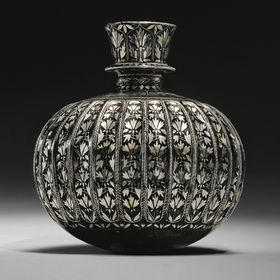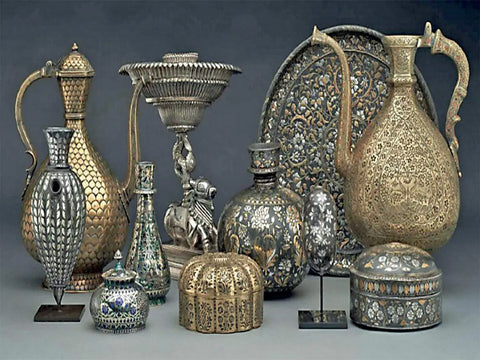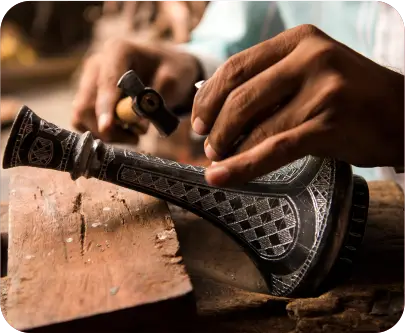Stunning and breathtaking - are the only two words that rightly describe the beauty and elegance of bidri craft. Introduced in the Bidar town of Karnataka, during the 14th to 15th centuries, Bidri craft is the epitome of exquisite artistry and rich cultural heritage.
From its origin in Persia to its travel to India with a Persian artist during the reign of Sultan Ahmed Shah Bahmani, bidri handicraft has come a long way. No matter the origin of Bidri work, this craft is now closely associated with India, especially Karnataka.
It’s believed that bidri art closely resembles the stars in the dark sky. Such is its charm, that items featuring bidri handicrafts are used as decor essentials in the homes and offices of aesthetes. Crafted from zinc, silver, gold, and copper, Bidri art has won the hearts of art & craft admirers all over the world for centuries with its intricate designs and unparalleled craftsmanship.
If you are looking for the exact definition of what is bidri work? the simplest answer to this is bidri craft is a process of ornamentation of metal objects using gold or silver. The copper or zinc items come alive when bidri artists inlay or overlay complex designs on them using brass, gold or silver.

Do all these sound too fascinating? There's more to the story! Let's explore the amazing history, origin, process, and strong influence of Bidri craft on the Indian handicraft market.
History & Origin of Bidri Craft
The roots of Bidri craft can be traced back to the 14th century, flourishing under the patronage of the Bahmani Sultans in Bidar, Karnataka. Legend has it that a Persian craftsman, Abdullah bin Kaiser, brought the art of Bidri to India while he was visiting the country to pay respect to the invitation of Sultan Ahmed Shah Wali. His pretty awesome idea to blend Persian bidri handicraft techniques with local craftsmanship took the craft to a new level of propriety and poise.
Another source is of the view that Abdullah bin Kaiser, himself was visiting India when he came in touch with a local goldsmith and the bidri art was the brainchild of both of their joint efforts.
Then again another source believes that it’s Moinuddin Hasan Chisti who brought bidri craft to India during his visit to the country from Iran.
So it’s safe to say that the inception period of bidri art in India is so old, that people often feel unsure of the period of its origin and the person who brought it in India. But one thing we all readily agree to is that without Persians, Indians wouldn’t have reached their modern level of popularity in bidri craft.
Over time, Bidri craft evolved, assimilating influences from Mughal, Persian, and Deccan art forms, resulting in its distinctive aesthetic appeal.
The craft’s influence was such that painters and artists of that time included bidri handicrafts in their miniature or regular paintings and their books.
During the reign of Ahmed Shah Bahmani, Bidri craft attained unprecedented popularity, decorating palaces, ceremonial objects, and everyday items with its sinuous patterns and motifs. The craft's association with royalty elevated its status, making it a symbol of wealth, prestige, and artistic excellence.

Process of Bidri Craft
While the origin of bidri handicraft is still wrapped under the shadow of confusion, there’s no denying the fact that the process of crafting Bidri art is highly labour-intensive. Following almost the same bidri handicraft process since its introduction in India, creating bidri art requires skill, precision, and attention to detail.
The first stage of bidri craft is the casting of the base object. Whether one is planning to design a box, vase or any other metal item, it must be made of zinc or copper. It serves as the canvas for the intricate designs to come.
Artisans then engrave the surface of the object with intricate designs and patterns, using chisels and fine-tipped tools. Following thousands of bidri craft items, the common patterns that are noticed in all of them are Tehnishan, Zarbuland, Mahtabi, Tarkashi, and Zarnishan.
Once the engraving is over, artists now hand etch thin silver wires for the inlaying process. The next step includes dipping the object into a solution or soil-based solution that’s collected from the inside of the bidar fort. You might question how this soil is different from any other soil, the answer is the soil used in bidri craft must not be wet or come in touch with water for years. In the Bidar township, it’s only found inside the Bidar fort. Such little details go into the entire process of creating Bidar art. Other than the soil, the solution includes ammonium chloride and water. This soil solution also leads the object to oxidise and it finally results in the formation of the much-awaited black coating on the surface.
Skilled craftsmen then employ a series of polishing techniques, using abrasive materials to reveal the intricate patterns beneath the darkened surface. The final result is a masterpiece of craftsmanship, characterised by its lustrous finish and exquisite detailing.

Bidri Craft's Influence on the Indian Handicraft Market
Over the centuries, Bidri Craft has reached the international stage overcoming geographical boundaries. Since its popularity worldwide, it has captivated the hearts of art connoisseurs across the globe with its timeless beauty and unparalleled craftsmanship. Its influence extends beyond borders, inspiring generations of artisans and designers to incorporate its motifs and techniques into contemporary works of art.
In modern times, Bidri craft continues to thrive, thanks to the efforts of passionate artisans, organisations, and stores like iTokri dedicated to preserving India's rich cultural heritage. With its elegance and long-lasting legacy, Bidri craft emerges as a top-tier example of India's artistic prowess.
Rangeen Mahal, Ashtur Tombs, Chaukhandi - all these historical structures have only one thing in common, they feature bidri art. The spread of bidri art was never limited to regular everyday objects. Since its inception in India, this art form has been decorating buildings, forts, and tombs. From all these structural beauties to the inside of your home and office, bidri handicraft is a wonder in itself.
Bidri craft is not just a traditional art form; it is a beautiful proof of India's rich cultural heritage, craftsmanship, and artistic ingenuity. From its humble origins in the medieval city of Bidar to its current great positioning in the global art scene, Bidri craft continues to win the hearts of its fans and aesthetes all over the globe. The influence of bidar art is not limited to boxes and vases, this craft has adorned trays, platters, hookahs, paan boxes and more. It’s such an exquisite art form that hundreds of wonderful stories are associated with it. From stories that seem like myths to stories with proof, the world of bidri craft is truly a wonderworld.
From being an art limited to the confines of Karnataka to now spread all across India West Bengal, Bihar, Maharashtra, and Uttar Pradesh, and even Britain also, the Indian craft is nowhere near halting its progress. ITokri has actively participated in India’s attempts to move forward with its emergence as a leading role in the export of handmade products. Along with India, iTokri delivers its handcrafted bidriware all over the world in the shortest possible time.
 Verified Purchase
Verified Purchase











































































































































































































Leave a comment (all fields required)